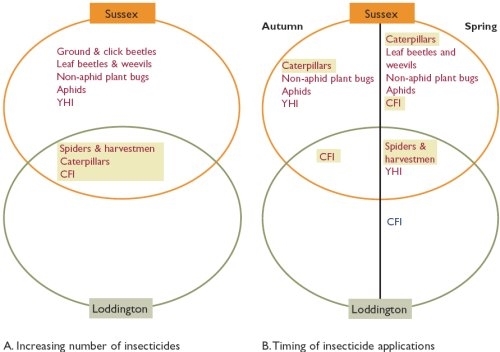Key findings
- Spring/summer applications of insecticides are more damaging than autumn ones.
- Organophosphate insecticides are especially damaging.
- To help farmland bird chicks, we advise reducing insecticide use, especially organophosphates.
The Game & Wildlife Conservation Trust is a worldwide leader in research into the effects of intensive modern agriculture on farmland birds.
Our work on the connection between invertebrate abundance, the survival of grey partridge chicks and the consequences for partridge breeding density is the best documented and most convincing link between the decline of a farmland bird and changes in its food supply.
We also pioneered methods to mitigate many of the effects of intensive agriculture on other farmland birds and wildlife. Much of this work has taken place on two areas where we have recently compared the relationships between pesticide use and invertebrate abundance, the Sussex study area and our demonstration farm at Loddington.
How the two study areas compare
The two study areas differ in size with the Sussex site covering 6,200 hectares whereas Loddington covers 350 hectares. They differ in the types of arable crops planted – a mixture of spring- and autumn-sown cereals, with spring and autumn’s own break crops in Sussex, and winter-sown cereals and break crops at Loddington.
They also differ in insecticide use. In Sussex, after an increase in insecticide use from 1970 to 1995 (both overall and in intensity) an average 70% of arable fields were treated with, on average, 1.4 insecticide applications per season from 1996 to 2004. At Loddington, from 1993 to 2004, there was no increase in the proportion of arable crops treated with insecticides (62%) or in the intensity of insecticide use, with an average of 1.2 treatments per arable crop per year. Of particular importance, however, Loddington used only pyrethroids and pirimicarb insecticides.
Invertebrates
Invertebrate samples are taken in Sussex and at Loddington annually in June. The invertebrate groups we chose for analysis were ones that figure prominently in the diet of farmland birds, especially at the chick stage. They included plant bugs and hoppers, caterpillars, leaf beetles and weevils, ground and click beetles, spiders and harvestman, aphids, and indices of chick food for three farmland bird species, grey partridges (CFI), corn buntings (CBI) and yellowhammers (YHI).
Our analysis took into account crop type, year and the use of herbicides and fungicides. The results of increasing numbers of insecticides, insecticide use in the autumn or spring, types of insecticide used are summarised in Figure 1. Only those invertebrate groups where we found significant results are listed, with the type of effect indicated – negative when the use of this type of insecticide treatment resulted in fewer invertebrates, positive when it resulted in more. When groups are listed within overlapping circles it means that significant results were found at both Sussex and Loddington.
The results support earlier work in Sussex. Insecticides decrease the number of invertebrates in fields, spring/summer applications are more damaging than autumn ones, organophosphate insecticides are especially damaging.
Although there are more significant adverse effects in Sussex, there are certain invertebrate groups, namely caterpillars, spiders and harvestmen and grey partridge chick food insects, where the negative effects of insecticide are the same. These results support our advice to reduce insecticide use, especially organophosphates, to benefit grey partridge chicks and other farmland birds.
Figure 1: Significant relationships between insecticide use and invertebrate groups in Sussex and Loddington

Significant negative results shown in red text
Significant positive results shown in blue text
Further reading
- Ewald, J.A., Aebischer, N.J., Brickle, N.W., Moreby, S.J., Potts, G.R. & Wakeham-Dawson, A. 2002. Spatial variation in densities of farmland birds in relation to pesticide use and avian food resources. In: Chamberlain, D.E. & Wilson, A. (eds) Avian Landscape Ecology: Pure and Applied Issues in the Large-Scale Ecology of Birds: 305-312. International Association for Landscape Ecology (UK).
- Ewald, J.A. & Aebischer, N.J. 2000. Trends in pesticide use and efficacy during 26 years of changing agriculture in southern England. Environmental Monitoring and Assessment, 64: 493-529.
- Ewald, J.A. & Aebischer, N.J. 1999. Pesticide Use, Avian Food Resources and Bird Densities in Sussex. JNCC Report No. 296, Joint Nature Conservation Committee, Peterborough.
- Ewald, J.A., Aebischer, N.J. & Potts, G.R. 1998. Increasing Pesticide Use: Impacts on Wildlife Based on 30 years of Monitoring. In: Proceedings of the Wildlife, Pesticides, and People Conference, chapter 15: 1-16. Rachel Carson Council Inc, Fairfax, Virginia, USA.
- Aebischer, N.J. & Sotherton, N.W. 1995. Long-term trends in food-resource availability in Sussex. In: Fuller, R.J. & Wilson, J.D. (eds) The Ecology of Seed-Eating Birds in Relation to Agricultural Practices: Current Research and Future Directions. BTO Research Report No. 149: 15-16. British Trust for Ornithology, Thetford.
- Aebischer, N.J. 1991. Twenty years of monitoring invertebrates and weeds in cereal fields in Sussex. In: Firbank, L.G., Carter, N., Darbyshire, J.F. & Potts, G.R. (eds) The Ecology of Temperate Cereal Fields: 305-331. Blackwell Scientific Publications, Oxford.
- Aebischer, N.J. 1990. Assessing pesticide effects on non-target invertebrates using long-term monitoring and time-series modelling. Journal of Functional Ecology, 4: 369-373.